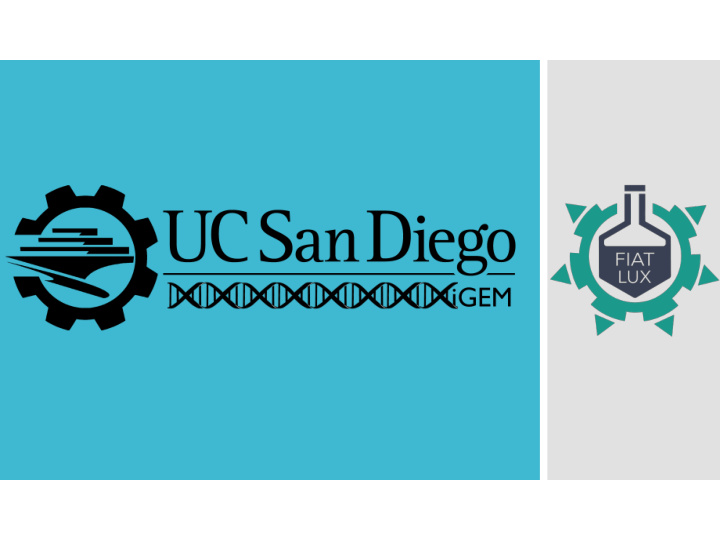



Problem Current approaches are limited in their ability to fully capture in vivo enzyme activity.
Goal Express and optimize the bacterial lux system in Saccharomyces Cerevisiae to find rate-limiting steps via stoichiometric control of enzyme levels.
Problem Statement
LUX SYSTEM Alpha Subunit Beta Subunit RNA Polymerase α β Reductase C Synthetase Transferase E D luxE luxD luxA luxB luxC
LUX SYSTEM Alpha Subunit Luciferase Beta Subunit α β α β Reductase C Synthetase Transferase E D luxE luxD luxA luxB luxC
LUX SYSTEM Luciferase α β Reductase C Synthetase Transferase E D luxE luxD luxA luxB luxC
LUX SYSTEM FATTY ACID RCOOH D
LUX SYSTEM E E C C FATTY ACID REDUCTASE C C COMPLEX E E FATTY ACID RCOOH D
LUX SYSTEM RCHO ALDEHYDE E E C C FATTY ACID REDUCTASE C C COMPLEX E E FATTY ACID RCOOH RCOOH D
REDUCED FLAVIN RCHO RCHO FMNH 2 FMNH 2 ALDEHYDE O 2 O 2 E E C C FATTY ACID α β LUCIFERASE REDUCTASE C C COMPLEX E E FATTY ACID RCOOH D
REDUCED FLAVIN RCHO FMNH 2 ALDEHYDE O 2 E E C C FATTY ACID RCOOH α β LUCIFERASE REDUCTASE C C COMPLEX E E OXIDIZED FLAVIN FMN FATTY ACID RCOOH H 2 O LIGHT D
STOICHIOMETRIC PROTEIN PRODUCTION C D E C C D E E C D E D E C D C D E E
Feature Purpose Bidrectional Promoter Modular plasmid construction Enhanced LuxAB Autonomous production of luminescence frp FMNH2 regeneration PLASMID P2A Linkers Stoichiometric protein DESIGN expression P2A Linker frp AB Dup C D E
Benefits + Optimize lux system in a eukaryotic organism + Improve flexibility and strength as reporter system + Develop modular platform to optimize other metabolic pathways
Problem Statement
Problem Statement
Chemical Reaction Network
Chemical Reaction Network
Chemical Reaction Network
Chemical Reaction Network
Chemical Reaction Network
Reaction Equations
Reaction Equations WelhamP, Stekel D (2009) Mathematical model of the lux luminescence system in the terrestrial bacterium Photorhabdus luminescens. Mol Biosyst 5(1):68 – 76. Iqbal M. , Stekel D. (2015). An extended mathematical model of Lux bioluminescence in bacteria. [unpublished]
System of Differential Equations WelhamP, Stekel D (2009) Mathematical model of the lux luminescence system in the terrestrial bacterium Photorhabdus luminescens. Mol Biosyst 5(1):68 – 76. Iqbal M. , Stekel D. (2015). An extended mathematical model of Lux bioluminescence in bacteria. [unpublished]
Model Assumptions ν LuxD = 2 ν LuxD 1 D C D E 2 Light LuxCDE = Light LuxCDE_E = Light LuxCDE_C 3 [O 2 ], [NADPH], [ATP], [H + ], [H 2 O] : constant Isolated system 4
Simulation Results
Simulation Results
Simulation Results B
Simulation Results C
Simulation Results
Problem Statement
Problem Statement
Reaction 1 A + B -> C Reaction 2 C + D -> E Flux Balance Analysis Reaction 3 A + D -> F . . . Reaction N 1 2 3 … V1 A -1 0 -1 … V2 B -1 0 0 … V3 0 C 1 -1 0 … V4 D 0 -1 -1 … V5 E 0 1 0 … V6 F 0 0 1 … V7 S v b
Constraint-Based Modeling Physical Constraints Infinite Solution Space Compartments: mitochondria, cytoplasm, extracellular, … Flux Boundaries: Lower Bound < v reaction < Upper Bound
Metabolic Burden (mmol/gDW*hr) (mmol/gDW*hr) Light and growth are strongly coupled!
Reactions Coupled to Light
Glycolysis Pentose Phosphate Pathway TCA Cycle Fatty Acid Biosynthesis Lux System Light
FUTURE DIRECTIONS Fitting model to experimentally validated parameters
Team THANK YOU Bart Borek Phillip Kyriakakis Jahir Gutierrez Todd Coleman
Recommend
More recommend